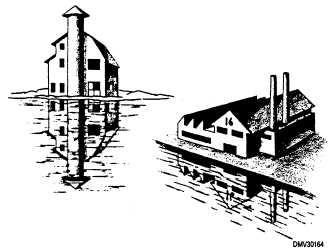Basic Rendering Techniques, Continued
Reflection
Light from surrounding surfaces reflects back onto an object. Therefore,
reflected light modifies shadow areas. Shiny or polished surfaces, such as
water, desk tops, floors, and metal objects act like mirrors and catch images
of their surroundings. Indicate the most prominent features in the reflection
without too much confusing detail. Often reflections are distorted depending
on the surface texture of the reflecting surface.
Figure 3-27 shows water reflecting the buildings on the shoreline above it.
Figure 3-27.—Reflections of buildings off water.
Light source
The direction light comes from alters the appearance of objects. Arrange a
light source to come from the direction that best emphasizes the form. Light
falling diagonally on subjects from above and to one side of the picture area
is the most natural form of illumination. Shadows cast from this position
create the greatest apparent depth and roundness. A lower angle of light
casts longer shadows. Side lighting is effective for showing texture. To
eliminate confusing edges and shadows, use a single light source rather than
several.
3-23

